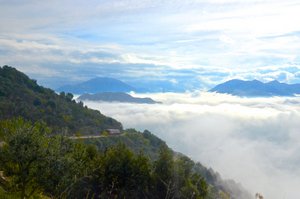Advertisement
Published: April 12th 2017

 Road in the clouds climbing up to the Benedictine Abbey of Montecassino.
Road in the clouds climbing up to the Benedictine Abbey of Montecassino.
If you look carefully you can see a bus on the road to the top of the mountain.This morning we left Sorrento and the amazing Amalfi Coast, heading north to our ultimate destination, Rome. To break up the 3 1/2 drive we stopped at the
Benedictine Abbey of Montecassino. The abbey is located on top of Monte Cassino, (also called Montecassino) a 1,706 foot high “hill” overlooking the town of Cassino. When we arrived the entire valley was engulfed in clouds. We began to break through the white billowy stuff as our bus wound up the narrow steep switchbacks to the mountain top. Perched high above the town of Cassino, the surrounding atmosphere gave a rather heavenly aspect to the abbey above the clouds.
This was previously a heavily pagan area.
Cassino, the town at the base of the mountain, was first settled in the fifth century BC by the Volsci people and were defeated by the Romans in 312 BC. Several Roman ruins have been excavated here including an amphitheater, theater and mausoleum. Generations after the Roman Empire, Christianity became the rule of the land.
According to legend, a pagan temple of Apollo crowned the hilltop and when St. Benedict arrived he smashed the sculpture
of Apollo and destroyed the pagan altar. St. Benedict wrote the Benedictine Rule which mandated the moral obligations to care for the sick, in so doing St. Benedict founded a hospital here that is considered to have been the first hospital in Europe. The Benedictine Abbey of Montecassino was established by St Benedict of Nursia in 529 AD. St Benedict spent his remaining days in this, one of the last remaining abbeys, within the Catholic Church.
The Benedictine monks were considered to be more intellectual than other monks, in part because of their notable achievements translating precious manuscripts into Latin. Much of the church doctrine was written here in this church and abbey but the monks also copied medical texts learning about human anatomy and methods of treatment giving them the ability to fulfill their obligation to care for the sick.
This Abbey was not without its struggles. An Earthquake damaged the Abbey in 1349, the site was sacked by Napoleon’s troops in 1799 and in 1944, during the Battle of Monte Cassino in the Italian Campaign of WWII, American bombers destroyed the Abbey and much around the area as a protection from the Nazis who were using
this area as a stronghold. History says this was one of the most important WWII battles in an effort to keep the Nazis out of Rome, and ultimately liberating Italy.
The abbey was totally rebuilt over several years after WWII. Talented craftsmen labored to create an impressive (and expensive) reconstruction with beautiful inlaid marble floor designs, multiple paintings, frescoes and sculptures. There was so much gold leaf throughout that the interior gleamed. I was especially impressed by the pale blue cloud-like ceiling surrounded by golden woven sculptures creating the effect of “heavenly” crowns. I am sure in part it was lovingly restored because of its part in the triumphant success in removing the Nazis from Italy. Despite the devastation that the Americans imparted on the area, the Italians are very grateful for American help in saving Italy. As we left we passed signs for
Historiale Di Cassino, an historical war museum to celebrate the 60th anniversary of the battle of Montecassino.
Descending as we must, from our heavenly heights, we wound back down the mountain’s curvaceous roads towards Rome. We made our last
Autogrille stop of the trip, an opportunity to have a light lunch and observe the
treats that locals might enjoy. I got a kick out of the metal chocolate boxes with movie billings printed on top such as from
La Dolce Vita and
Vacanze Romane (Roman Holiday) and all kinds of toys for the big and little kids among us.
It was pretty obvious when we entered
Rome because the traffic thickened to an eventual standstill. Our bus navigated through the major wall entering into the historic center of Rome passing such highlights as the Piazza Victor Manuele, the Colosseum, Santa Majorie the Forum, and then the Vatican.
By the time we reached the
Hotel Albani Roma, everyone on the bus was either coughing sneezing or blowing their nose. Or all three. Apparently the sun and warm temperatures from our week in the Amalfi Coast did little to abate the colds we all were now suffering from. And yet our appetites did not diminish! After unpacking, the entire “GCT family group” met for a farewell dinner to say happy birthday to Larry who turned 70 and goodbye and thanks to Ben, our guide, and to the many member-friends of the group who were not staying on in Rome, hoping we would all stay
in touch.
Advertisement
Tot: 0.105s; Tpl: 0.012s; cc: 20; qc: 24; dbt: 0.0463s; 1; m:domysql w:travelblog (10.17.0.13); sld: 1;
; mem: 1.1mb







